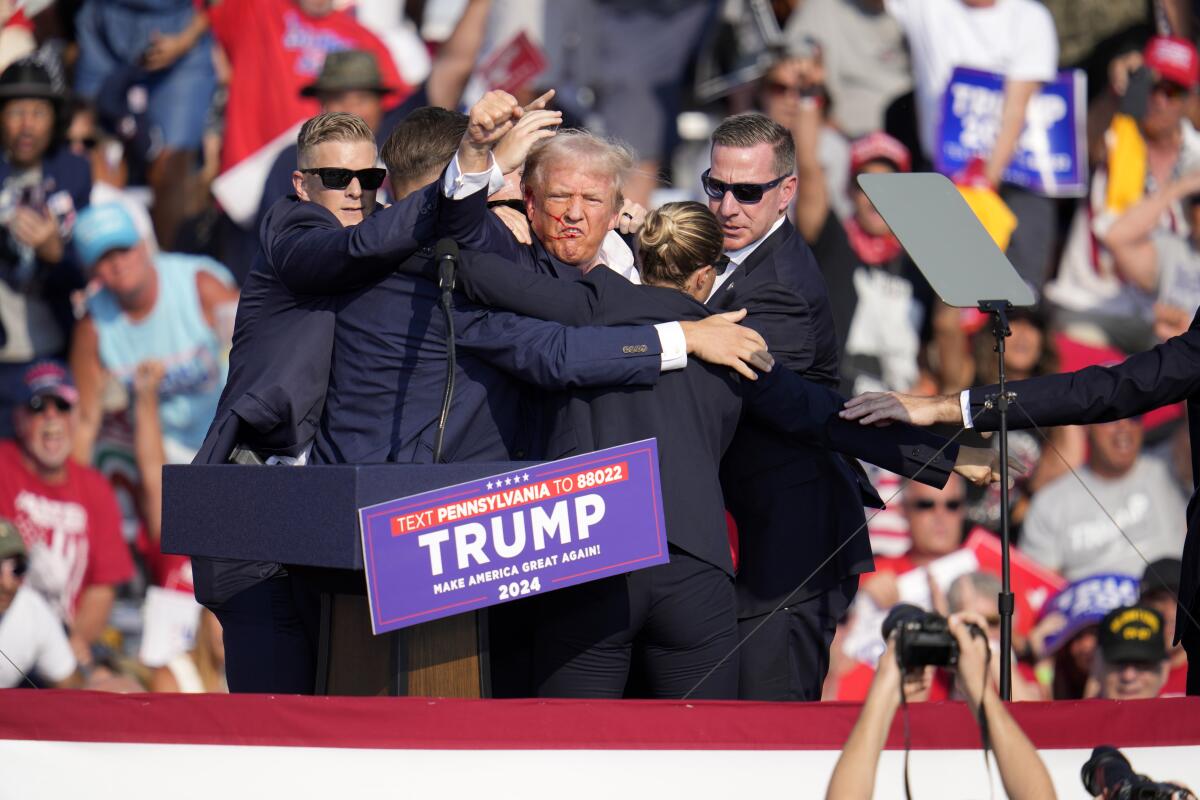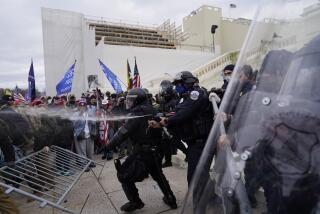Trump shooting is a historic moment echoing past political violence in America

- Share via
A campaign season already marred by threats and insults is now stained by deadly violence in the latest dark chapter in a polarized America.
Former President Trump was injured in a shooting at a campaign rally in Butler, Pa., on Saturday, an assault that seemed poised to upend a bitter presidential race and offered eerie echoes of attempts on the lives of past candidates, among them Theodore Roosevelt and Gerald R. Ford.
Footage from the event showed Trump grab at his right ear and go down after gunshots rang out. Quickly rising to his feet amid a phalanx of U.S. Secret Service agents, Trump pumped a fist at the crowd as blood seeped from the side of his head.
Shortly after Trump was hustled off stage by his security detail, a spokesman for the presumptive Republican nominee said he was “fine” and being examined at a nearby medical facility. The shooting left one rally attendee dead and two critically injured, and the unidentified gunman was killed by the Secret Service, according to that agency.
Political leaders from across the spectrum denounced the attack. President Biden said in a statement that he was “grateful to hear that [Trump’s] safe and doing well. I’m praying for him and his family and for all those who were at the rally.”
The history of violence on the presidential campaign trail stretches back more than 100 years. Perhaps the most notable attack was the 1968 assassination of Robert F. Kennedy, then a leading candidate in the Democratic presidential primaries. That shooting, at the Ambassador Hotel in Los Angeles, was a defining moment in an era of American acrimony.
Though it has been more than 40 years since a president or presidential candidate endured an assassination attempt, more recent history is rife with examples of political violence, including the shooting of Rep. Steve Scalise, a Republican from Louisiana, during a congressional baseball game practice in 2017; the brutal attack on former House Speaker Nancy Pelosi’s husband at the Democratic lawmaker’s San Francisco home in 2022 and the Jan. 6, 2021, riots at the U.S. Capitol.
“Political violence is very much, unfortunately, a fact of our own time,” said Allan Lichtman, a distinguished professor of history at American University.
And amid a campaign laced with invective — Trump has called Biden a “broken-down pile of crap,” and the Democrat has dubbed his challenger a “sucker” and a “loser” — political violence has been part of the discourse from the start. That’s in part because of the Jan. 6 attack on the U.S. Capitol by insurrectionists attempting to block certification of the vote for the 2020 presidential election.
Throughout the campaign, Biden has sought to tie Trump to the actions of the rioters. But the U.S. Supreme Court this month ruled that presidents have absolute immunity for exercising core powers, throwing into doubt prosecutors’ ability to hold the former president to account for his alleged efforts to subvert Biden’s victory.
The shooting was the first attempt on the life of a president or candidate for the office since 1981, when John W. Hinckley Jr. shot President Reagan. And like several presidential candidates targeted before him, Trump was attacked at a political rally, highlighting the risks of the campaign trail.
In 1912, during his campaign for a third presidential term, Theodore Roosevelt was shot just before he was scheduled to make a speech at an event in Milwaukee. With a bullet lodged in his chest, Roosevelt went ahead with his remarks, famously quipping, “It takes more than that to kill a Bull Moose,” a reference to the nickname of his political party.
President Ford, who’d assumed the office after Richard Nixon resigned in 1974 amid the Watergate scandal, was the target of back-to-back assassination attempts. They occurred in September 1975, over a span of 17 days during which Ford made visits to California about a year before the election in which he’d seek, and ultimately lose, a full term in office.
In the first episode, Ford was in downtown Sacramento for a sit-down with then-Gov. Jerry Brown. While walking to the meeting, the president stopped to shake hands with people who had lined up to greet him. Lynette “Squeaky” Fromme, a follower of Charles Manson, stood out in the crowd wearing a long red dress. Ford moved to shake Fromme’s hand. Instead, she pointed a handgun at his stomach. One of Ford’s Secret Service agents saw the weapon and grabbed it before it went off. Ford was ushered to the Capitol, where he took the meeting with Brown.
Less than three weeks later, Sara Jane Moore fired at Ford as he was leaving a speaking engagement at a San Francisco hotel. Moore was a former FBI informant who had been treated for mental illness and was reportedly interested in radical politics. Her shot missed the president by several feet.
A year after surviving the assassination attempts, Ford was defeated by Democratic nominee Jimmy Carter.
Eric Schickler, a political science professor and co-director of the UC Berkeley Institute of Governmental Studies, said the Trump shooting may be shocking to some, in part because many Americans don’t remember the numerous high-profile political assassinations — and thwarted ones — in the 1960s and ’70s.
“In 1975,” Schickler said, referencing the attempts to kill Ford, “that’s still in the aftermath of the ’60s, where you have John F. Kennedy, Robert Kennedy, Martin Luther King … as well as a number of political bombings and political violence.
“It’s a very different kind of moment in a lot of ways than what we have right now,” he said. “It’s outside the experience of so many Americans.”
The murder of U.S. Sen. Robert F. Kennedy on June 5, 1968, was an epoch-defining moment. Kennedy — the leading contender to be the Democratic presidential nominee — delivered a speech at the Ambassador to mark his victory in the California primary. As Kennedy left the stage and exited through the kitchen, he encountered Sirhan Sirhan, who shot him three times with a .22-caliber revolver.
Kennedy was taken to Good Samaritan Hospital, where he was pronounced dead the next day. The assassination took place on the anniversary of the Six-Day War between Israel and Arab nations. Born into a Christian family in Palestine and raised in Pasadena, Sirhan was believed to be motivated by Kennedy’s pro-Israel stance.
The Ambassador was demolished in 2006; a complex of public schools has since been erected in its place and is named for Kennedy.
Robert F. Kennedy Jr., a third-party presidential candidate and one of the late statesman’s children, took to social media to call for calm after Trump’s shooting.
“Now is the time for every American who loves our country to step back from the division, renounce all violence, and unite in prayer for President Trump and his family,” Kennedy Jr. said on X, formerly known as Twitter.
Lichtman, the American University professor, said it was too soon to gauge the political repercussions of Saturday’s shooting. But he expressed concern that Republicans would use the attack to assail Democrats, running the “danger of whipping up more political violence.”
“It is the height of irresponsibility when we know nothing about the shooter or the motivations, to make this political, to blame it on the president, the former president’s political opponents, on Joe Biden, on the Democrats,” Lichtman said. “That is beyond tragic. The only result of that would be to perpetrate more political violence.”
More to Read
Sign up for Essential California
The most important California stories and recommendations in your inbox every morning.
You may occasionally receive promotional content from the Los Angeles Times.













